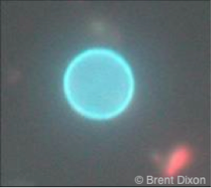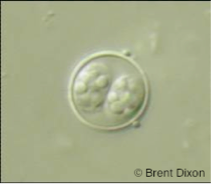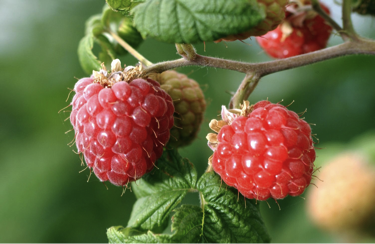Cyclospora cayetanensis
Contributor: Brent Dixon
Biology: Identified as a coccidian protozoan parasite and named in early 1990’s. Humans are the only host for this species.


Figure 1. Two images of Cyclospora oocysts (left: UV fluorescence microscopy; right: wet mount).
Life Cycle: Transmission stage (oocyst) is spherical and 8-10 µm in diameter. Unsporulated (immature) oocysts are shed into the environment with the faeces of infected individuals. Oocysts undergo sporulation, becoming mature and infectious within 7-15 days.

Figure 2. Cyclospora cayetanensis life cycle (Source: CDC).
Transmission: Early outbreaks were waterborne. Since mid-1990’s foodborne outbreaks have been reported annually in Canada and the U.S. Foodborne outbreaks mainly associated with the consumption of fresh imported produce, including raspberries, blackberries, mesclun, basil, snow peas.

Figure 3. Foodborne outbreaks are mainly associated with the consumption of fresh imported produce, such as raspberries.
Prevalence: Reported worldwide; endemic in Haiti, Peru, Guatemala, Nepal; 151 cases reported in Canada in 2008
Susceptible Populations: Immunocompromised persons, travellers
Symptoms: Diarrhea, loss of appetite, abdominal cramps, bloating, nausea, fatigue
Treatment: bactrim (sulfamethoxazole and trimethoprim) is the drug of choice
Control Measures: Good agricultural practices including use of filtered water in irrigation, mixing pesticides, processing, and washing hands and equipment; good worker hygiene (hand washing). Cyclospora is resistant to chemical disinfectants. At consumer/food handler level, good hygiene is important, washing of fruits and vegetables is recommended, when possible, cooking and freezing are effective in destroying Cyclospora.